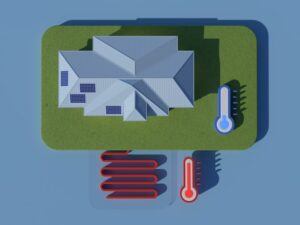If you’re having issues with your gas heater, resetting it may be the solution. A gas heater reset is a simple process that can help you restore your heater to its working condition. Today we’ll cover how to reset a gas heater along with the important safety precautions to take.
Proper maintenance of your gas heater is essential to ensure its optimal performance. However, even with proper maintenance, your heater may still require a reset. Before resetting your gas heater, it’s important to turn off the power supply and follow all safety precautions to avoid any potential hazards.
At Excel Mechanical, we’re committed to providing exceptional quality and great value for both residential and commercial HVAC and plumbing services. Our team of professionals is knowledgeable and experienced in handling a wide range of heating and cooling systems. Whether you need routine maintenance, repairs, or a complete system replacement, we’ll work with you to provide the best possible solution to meet your needs and budget.
Safety Measures Before Resetting Your Gas Heater
Before resetting your gas heater, it is important to take necessary safety measures to avoid any potential hazards. In this section, we will discuss the importance of safety, locating and operating the main gas supply, and ensuring proper ventilation.
Understanding the Importance of Safety
Safety should always be your top priority when dealing with gas appliances. Gas leaks and explosions can lead to serious injuries or even death. Therefore, before resetting your gas heater, it is important to ensure that you have taken all the necessary safety measures.
Locating and Operating the Main Gas Supply
Before resetting your gas heater, locate and operate the main gas supply. The gas supply valve is usually located near the appliance and can be turned off by rotating it to the “Off” position. It is important to ensure that the gas supply is turned off before attempting any reset procedures.
Ensuring Proper Ventilation
Proper ventilation is essential when dealing with gas appliances. Before resetting your gas heater, ensure that the area is properly ventilated. Open all windows and doors to allow fresh air to circulate in the room.
Remember, safety should always come first when dealing with gas appliances. By taking the necessary safety measures, you can avoid potential hazards and ensure the safety of your home or business.
Identifying the Cause of a Malfunction
Gas heaters are a popular choice for warming homes during the cold months. However, sometimes they may malfunction. When this happens, it’s important to identify the cause of the problem before attempting any repairs. In this section, we’ll discuss how to troubleshoot common issues and when to seek professional assistance.
Troubleshooting Common Issues
Before calling for professional assistance, it’s always a good idea to troubleshoot the problem yourself. Here are some common issues you may encounter and how to troubleshoot them:
- Pilot Light: If the pilot light is out, relight it according to the manufacturer’s instructions. If it won’t stay lit, there may be a problem with the thermocouple, which is a safety device that shuts off the gas if the pilot light goes out. Check the user manual for instructions on how to replace the thermocouple.
- Dirty or Clogged Burner: A dirty or clogged burner can cause the heater to malfunction. Turn off the gas and power to the heater, then clean the burner according to the manufacturer’s instructions.
- Malfunctioning Thermostat: If the heater won’t turn on or off, or if it won’t maintain a consistent temperature, the thermostat may be malfunctioning. Check the user manual for instructions on how to troubleshoot and replace the thermostat.
When to Seek Professional Assistance
If you’re unable to troubleshoot the problem yourself, or if you’re uncomfortable working with gas or electricity, it’s best to seek professional assistance.
Identifying the cause of a gas heater malfunction is essential for safe and effective repairs. By troubleshooting common issues and seeking professional assistance when necessary, you can ensure that your gas heater is functioning properly and efficiently.
Step-by-Step Guide to Resetting Your Gas Heater
If you’re having trouble with your gas heater, resetting it might be the solution. Here’s a step-by-step guide to help you reset your gas heater.
Accessing the Control Panel
Before you start resetting your gas heater, make sure to turn off the gas supply to the heater. This can be done by locating the gas valve near the appliance and turning it to the “Off” position. Once you’ve done that, you can access the control panel of your gas heater.
Locating the Reset Button
Most gas heaters, including Rinnai gas heaters, have a dedicated reset button. This button is usually located on the control panel of the heater. If you’re having trouble locating the reset button, consult your owner’s manual or the manufacturer’s instructions.
Performing the Reset Procedure
Once you’ve located the reset button, press it firmly to reset the gas heater. You may need to hold the button down for a few seconds to ensure that the reset is successful. After you’ve performed the reset procedure, turn the gas supply back on and test the heater to make sure it’s working properly.
If you’re still having trouble with your gas heater, it’s best to call a professional for help.
Post-Reset Checks and Maintenance
After resetting your gas heater, it is important to conduct some post-reset checks and maintenance to ensure that your heater is in good working condition. In this section, we will discuss the different checks and maintenance tasks you need to perform.
Verifying the Pilot Light and Burner Operation
After resetting your gas heater, you need to verify that the pilot light and burner are working correctly. Check the pilot light to ensure that it is lit and burning steadily. If the pilot light is not lit, you may need to relight it. You can refer to the manufacturer’s manual for instructions on how to do this.
Next, check the burner to ensure that it is operating correctly. Turn on the heater and observe the burner. The flame should be blue and steady. If the flame is yellow or flickering, it could be an indication of a problem with the burner. In this case, you should contact a professional HVAC technician to inspect and repair the heater.
Adjusting the Thermostat Settings
After resetting your gas heater, you may need to adjust the thermostat settings to ensure that your heater is operating at the desired temperature. Check the thermostat and adjust the temperature settings as needed. It is important to note that setting the temperature too high can cause your heater to work harder than necessary, resulting in higher energy bills.
Conducting Regular Maintenance
To ensure that your gas heater continues to operate efficiently and effectively, it is important to conduct regular maintenance. This includes cleaning the heater, replacing air filters, and inspecting the heater for any signs of wear or damage. Regular maintenance can help prevent breakdowns and extend the life of your heater.
Preventive Measures and Long-term Care
When it comes to your gas heater, preventive measures and long-term care are essential to ensure its efficiency and lifespan. By scheduling regular professional inspections, you can identify and solve any potential problems before they become major issues.
Scheduling Professional Inspections
At Excel Mechanical, we offer professional HVAC and plumbing services for both residential and commercial clients. Our team of experts can provide regular inspections to ensure that your gas heater is running smoothly and efficiently. During these inspections, we will check for any leaks, cracks, or other issues that could affect the performance of your heater.
Regular inspections can also help to extend the lifespan of your gas heater. By catching and fixing problems early on, you can avoid costly repairs or replacements down the line. At Excel Mechanical, we are committed to providing exceptional quality and great value to all of our clients.
Get in touch to see what we can do for you.
Enhancing Efficiency and Lifespan
In addition to scheduling professional inspections, there are several other steps you can take to enhance the efficiency and lifespan of your gas heater. One of the most important things you can do is to perform regular maintenance on your heater. This includes cleaning the burner and heat exchanger, replacing air filters, and checking the venting system.
Another way to enhance the efficiency of your gas heater is to upgrade to a newer, more energy-efficient model. We work with a variety of top brands to provide the best possible system to meet your individual needs and budget. By upgrading to a more efficient model, you can save money on your energy bills and reduce your carbon footprint.
By scheduling regular professional inspections, performing regular maintenance, and upgrading to a more efficient model, you can ensure the efficiency and lifespan of your gas heater.




